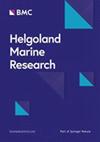Age and growth of Glycymeris longior (Sowerby, 1832) clam at the southern edge of its distribution (Argentine Sea)
4区 地球科学
Q2 Agricultural and Biological Sciences
引用次数: 5
Abstract
Even though Glycymeris longior is a clam widely distributed in the SW Atlantic Ocean, little is known about its biology and life history. The present study assessed the periodicity of the internal growth increments of G. longior using thin shell sections. Each internal growth increment was composed of two alternating bands: a translucent band (light-coloured when viewed with transmitted light) and an opaque band (dark-coloured). Annual formation for each pair of bands was demonstrated. The formation of the annual growth increments was synchronous among individuals. Growth was determined from live clams collected at El Sótano, Argentine Sea (age range = 29 to 69 years). According to the growth model, G. longior grows fast during the first 5 years of life and then growth becomes slower in later years; individuals reached 50% and 90% of maximum size at 5 and 13 years of age, respectively. High variability was found in shell height for the first 10 years: differences up to 5–7 mm among individuals were registered for the first 2 years of age, and up to 11 mm between the ages of 3 and 9 years. The growth performance index phi-prime (φ′) and the index of growth performance (P) of G. longior were compared with those of other Glycymeris species. Our results indicate that G. longior is a slow-growing species with a long lifespan (maximum longevity = 69 years).阿根廷海长蛤(Glycymeris longior, Sowerby, 1832)分布南缘的年龄和生长
尽管长角蛤是一种广泛分布于大西洋西南部的蛤,但人们对其生物学和生活史知之甚少。本研究采用薄壳切片法测定了长叶藻内部生长增量的周期性。每个内部生长增量由两个交替的波段组成:一个半透明的波段(用透射光观察时呈浅色)和一个不透明的波段(深色)。论证了每对波段的年度形成。年生长增量的形成在个体间是同步的。从阿根廷海El Sótano收集的活蛤(年龄范围为29至69岁)中测定生长情况。根据生长模型,长叶竹在生命的前5年生长较快,随后生长缓慢;个体在5岁和13岁时分别达到最大体型的50%和90%。前10年的壳高差异很大:个体之间的差异在前2年可达5-7毫米,在3至9岁之间可达11毫米。比较了长叶甘菊与其他甘菊属植物的生长性能指数phi-撇(φ ')和生长性能指数P。结果表明,长叶竹是一种生长缓慢、寿命长(最长寿命69年)的植物。
本文章由计算机程序翻译,如有差异,请以英文原文为准。
求助全文
约1分钟内获得全文
求助全文
来源期刊

Helgoland Marine Research
地学-海洋学
自引率
0.00%
发文量
0
审稿时长
6-12 weeks
期刊介绍:
Helgoland Marine Research is an open access, peer reviewed journal, publishing original research as well as reviews on all aspects of marine and brackish water ecosystems, with a focus on how organisms survive in, and interact with, their environment.
The aim of Helgoland Marine Research is to publish work with a regional focus, but with clear global implications, or vice versa; research with global emphasis and regional ramifications. We are particularly interested in contributions that further our general understanding of how marine ecosystems work, and that concentrate on species’ interactions.
 求助内容:
求助内容: 应助结果提醒方式:
应助结果提醒方式:


